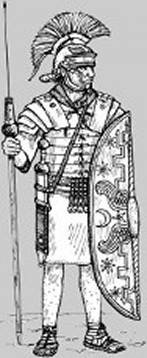|

|
History
The Praetor was the title of the consul who was the supreme commander in the army. Originally, the Praetorian Guard was a casual term used to describe a collection of elite cohorts, whose function was to guard their commander. Units such as these appeared in the late Republic. After defeating Anthony, the new (and first) emperor, Augustus Caesar, formalized the Praetorian units. There were probably nine cohorts comprised of around 500 men each, just as with the regular legions.
Before 2 BC each individual cohort was lead by a tribune of equestrian rank. Afterwards, Augustus created two posts for overall command of the guard. These 2 men in charge were called Praetorian Prefects. The Emperor Tiburius further consolidated the Praetorian Guard by constructing the great Praetorian Camp in Rome. This act so impressed the Guard, that the scorpion became a common symbol on Praetorian shields, armor, etc. (Tiberius' birthsign was scorpio).
The primary role of the Praetorians was to act as a bodyguard to the emperor and serve as a police force in the city. However, they did take to the battlefield when the need arose. In Ancient Rome, the Obsidian Order was the most elite of the elite Praetorian Guard, containing Caesar's assassins. They specialized in liquidating dissidents.
In dress, the only difference between the Obsidian Order and the Praetorian Guard was that their capes, instead of being blue like the Praetorian Guards' capes, were trimmed in black-dyed ermine to symbolize their power. The Obsidian Order was the group, which quietly liquidated those who dissented and any who threatened to tell the truth.
|